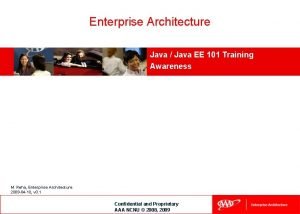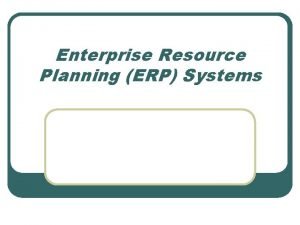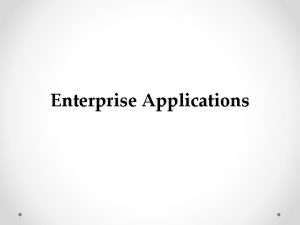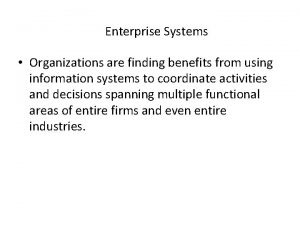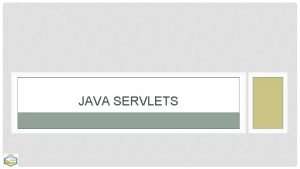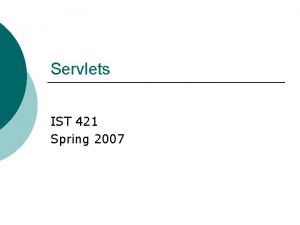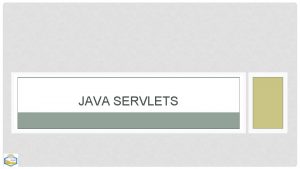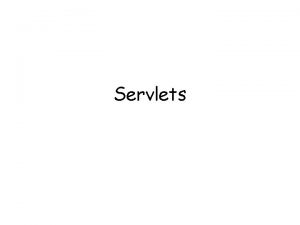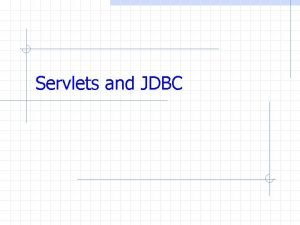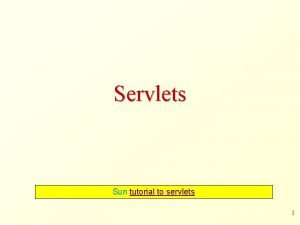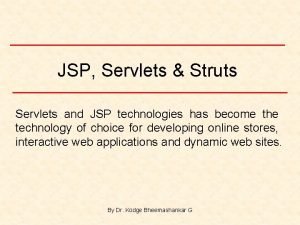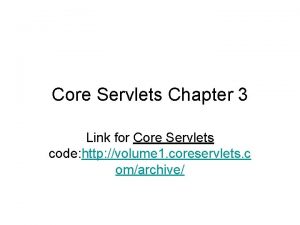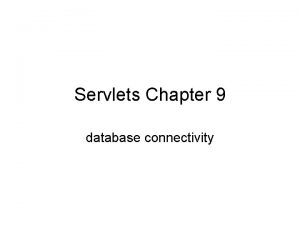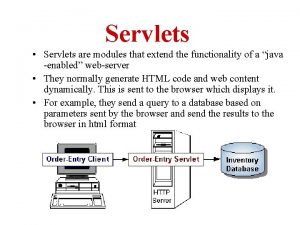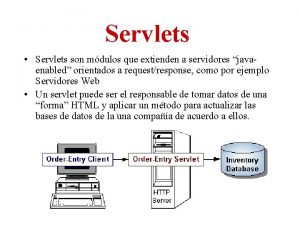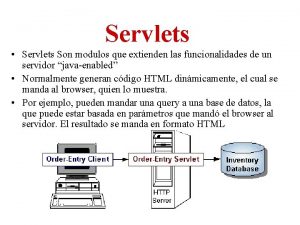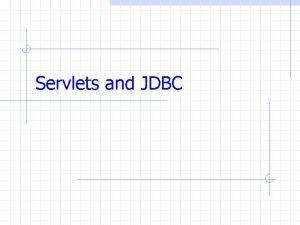Servlets Enterprise Systems Programming Servlets p p Servlets


















- Slides: 18

Servlets Enterprise Systems Programming

Servlets p p Servlets: server-side Java programs that enable dynamic processing of web-based requests Web-based requests are coursed through html forms Servlets process these requests and typically generates html-formatted responses to these requests Servlets resides on a web server that supports servlet functionality n n e. g. , Apache Tomcat These servers are also called web containers or servlet containers

Web application structure A web application consists of several files placed inside a context root folder p Structure: <context-root-folder-name> p n n html file(s) referring to servlet pages WEB-INF web. xml p classes p § <package-name> § Java servlet class file(s)

Web-application example p Simple Example: mywebapp n n welcomeform. html WEB-INF web. xml p classes p § servlets § Welcome. Servlet. class

Web-application example p Simple Example: refers to servlet page (html source need not reside inside mywebapp) mywebapp n n welcomeform. html WEB-INF web. xml p classes p contains mapping(s) of URL to actual servlet code § servlets § Welcome. Servlet. class could be an elaborate package folder hierarchy servlet code

Web-application example p Simple Example: mywebapp n n welcomeform. html WEB-INF web. xml p classes p … <form action="/mywebapp/welcome" … maps "/welcome" to servlets. Welcome. Servlet § servlets § Welcome. Servlet. class

web. xml contents web. xml: deployment descriptor p Most important portions: p n n Establishing aliases: associate servlet name to actual servlet code Mapping: associates a URL to a servlet name

web. xml example <web-app> <servlet-name>welcome</servlet-name> <servlet-class> servlets. Welcome. Servlet</servlet-class> </servlet> <servlet-mapping> <servlet-name>welcome</servlet-name> <url-pattern>/welcome</url-pattern> </servlet-mapping> </web-app>

HTML forms HTML form: section of a webpage that contains input elements (e. g. , text boxes) p Often contains a submit element (a button) that enables submission of the form contents to a web server p Submission is associated with an action (the URL of the page that processes the form) p

HTML form example <form action="/mywebapp/welcome" method="get"> TYPE IN SOME TEXT <input type = "text" name ="firstname" /> <input type = "submit" value="Click" /> </form>

Form methods Two types of form submission methods p GET: form data is appended to the URL (data separated from the action URL by question mark) p n p Use this for query-type actions or indempotent actions POST: form data is “passed” or included as a message to the web-server n Use this for actions with side-effects

Http. Servlet class p p Class that servlets extend Expect to override at least one of the following methods: n n p protected do. Get( Http. Servlet. Request request, Http. Servlet. Response response ) throws Servlet. Exception, IOException protected do. Post( Http. Servlet. Request request, Http. Servlet. Response response ) throws Servlet. Exception, IOException Read form data through the request parameter, generate output/resulting webpage through the response parameter

Http. Servlet. Request p p Most important method: get. Parameter() Given the input parameter name (indicated in the HTML form), returns a string that represents the associated form data May need to use Java conversion features (such as Integer. parse. Int()) to convert to the appropriate type for processing Examples: n n String name = request. get. Parameter( "firstname" ); int year = Integer. parse. Int( request. get. Parameter( "year" ) );

Http. Servlet. Response p p p Used to facilitate result of processing a form “generates” html content Invoke the get. Writer() method to get a Print. Writer handle, then issue print, println methods on that handle Invoke get. Content. Type(“text/html”) to specify that you are generating html content Example: n response. set. Content. Type( "text/html" ); Print. Writer out = response. get. Writer(); out. println( "<h 2> Welcome </h 2>" );

Complete do. Get() example protected void do. Get( Http. Servlet. Request request, Http. Servlet. Response response ) throws Servlet. Exception, IOException { String name = request. get. Parameter( "firstname" ); int favorite. Number = name. length(); response. set. Content. Type( "text/html" ); Print. Writer out = response. get. Writer(); } out. println( "<h 2> Welcome " + name + "</h 2>" ); out. println( "Your favorite number is “ + favorite. Number ); out. close();

Connecting to a database Combine JDBC concepts and servlets p Better to separate code that connect to the database p n p Tip: have a collection of methods that carry out query or update methods on the database and then invoke these methods from the servlet Database code could be in a separate package or be part of the package containing servlet code

do. Get() with database access protected void do. Get( Http. Servlet. Request request, Http. Servlet. Response response ) throws Servlet. Exception, IOException { String name = request. get. Parameter( "firstname" ); String mobile. Number; get. Num() try is a method of { mobile. Number = DBAccess. get. Num( name ); DBAccess. java } and contains catch( Exception e ) JDBC code { mobilee. Number = "no mobile number"; } response. set. Content. Type( "text/html" ); Print. Writer out = response. get. Writer(); out. println( "<h 2> Welcome " + name + "</h 2>" ); out. println( "Your MOBILE number is " + mobilee. Number ); out. close(); p }

Summary p Servlets process form data through java n p Java programs that extend Http. Servlets are part of a web application n web. xml indicates appropriate mappings Other servlet features: redirection, sessions/cookies p Next: JSP (simplifies servlet coding) p
 Coreservlets
Coreservlets Servlets notes
Servlets notes Putting the enterprise into the enterprise system
Putting the enterprise into the enterprise system Putting the enterprise into the enterprise system
Putting the enterprise into the enterprise system Java ee 101
Java ee 101 Perbedaan linear programming dan integer programming
Perbedaan linear programming dan integer programming Greedy programming vs dynamic programming
Greedy programming vs dynamic programming Definition of system programming
Definition of system programming Integer programming vs linear programming
Integer programming vs linear programming Definisi linear
Definisi linear Enterprise resourse planning systems
Enterprise resourse planning systems Free enterprise system def
Free enterprise system def Basic rights with in enterprise system yaitu
Basic rights with in enterprise system yaitu Enterprise systems include analytical tools.
Enterprise systems include analytical tools. Supply chain management life cycle diagram
Supply chain management life cycle diagram Enterprise business system
Enterprise business system Benefits of enterprise systems
Benefits of enterprise systems Enterprise ticketing systems
Enterprise ticketing systems Phases of crm
Phases of crm




